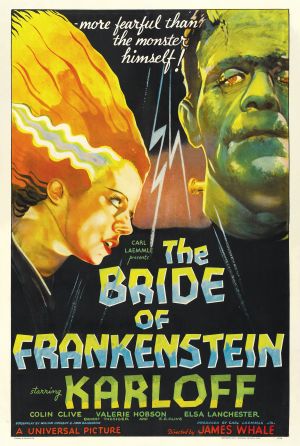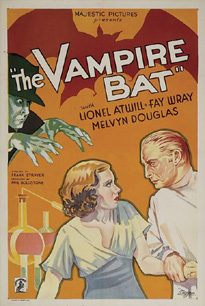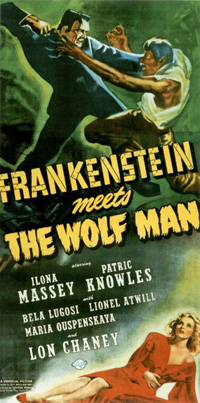    
Dwight
Frye was born in Salina, Kansas
on February 22nd 1922.
The youngster was raised a
Christian Scientist. Early on he
received training in voice and
piano and was originally moving
towards a goal in music. However,
fate intervened and he found
himself drawn to the theater.
After touring with several
companies he ended up in New York
where he found success in a
variety of roles as a stage
actor. He was the original “Young
Man” in the debut of Luis
Pirandello’s ‘Six
Characters in Search of An Author’
and was also in ‘The
Devil in the Cheese’
in 1926 with Bela Lugosi. In
Aughust 1st 1928 he
married stage actress Laura Mae
Bullivant. They opened a popular
tearoom in NY. The following year
the stock market crash dried up
their business and put a serious
dent on the Broadway shows being
produced.
Having
already been in the film ‘The
Night Bird’ (1928),
Dwight and his wife decided to
relocate to Los Angeles during
the great migration of stage
actors flocking to Hollywood at
the dawn of the talkie era. The
couple welcomed a son, Dwight
Jr., into the world the day after
Christmas 1930.
Dwight
found work in Hollywood and acted
in several films before making
the first of two pictures in 1931
that would make him a screen
immortal, as well as stereotype
him for the rest of his career.
He was the original Renfield, the
fly and spider munching real
estate agent who becomes the
vampire’s first victim in
‘Dracula’ (1931)
opposite the incomparable Bela
Lugosi. That same year he also
played the doctor’s
wild-eyed and hunchbacked
assistant Fritz in James Whale’s
‘Frankenstein’
with Boris Karloff (The Monster),
Mae Clarke, and Colin Clive (Dr.
Henry Frankenstein). Also of
note: that same year he was
Wilmer in the original screen
version of Dashiell Hammett’s
‘The Maltese Falcon’,
but it was far overshadowed at
the Universal Studios by his
impact in the previous two roles.
The casting
office had him pegged. For the
remainder of his film career he
was cast as crazed assistants,
lunatics, spies, shifty
characters, psychopaths, and the
like in countless pictures –
‘The Black Camel’
(1931) – an early Charlie
Chan picture with Warner Oland as
the detective, ‘A
Strange Adventure’
(1932), ‘The Vampire
Bat’ (1933), ‘The
Circus Queen Murder’
(1933), ‘The Invisible Man’
(1933), ‘The Bride
of Frankenstein (1935)
as Karl, ‘The Crime
of Dr. Crespi’
(1935) with Erich von Stroheim,
‘Alibi For Murder’
(1936), ‘The Man Who
Found Himself’
(1937), ‘The Shadow (1937)
as Vindecco, ‘The
Invisible Enemy’
(1938), ‘The Night
Hawk’ (1938),
‘Who Killed Gail
Preston?’ (1938) as
Mr. Owen, ‘The Drums
of Fu Manchu’
(1940), ‘The Mystery
Ship’ (1941),
‘The Ghost of
Frankenstein’
(1942), ‘Dead Men
Walk’ (1943) as an
evil hunchback named Zolarr who
is henchman (or would that be
hunchman?) to vampire Elwyn
Clayton, ‘Hangmen
Also Die’ (1943),
‘Frankenstein Meets
the Wolf Man’
(1943), etc. His film parts were
growing progressively smaller and
the films increasingly less
distinguished. Throughout this
period he also returned
periodically to the stage where
he could at least experience some
variety in his roles (comedies
and even musicals!). However, in
this period he also played
Renfield on a staged revival of
‘Dracula’.
Discouraged
by his film career and eager to
help with the war effort -- he
eventually took a night job as a
draftsman and tool designer at
Lockheed Aircraft Company in Los
Angeles, working there between
film assignments.
In 1943 he
was offered the role of Secretary
of War Newton D. Baker in the
A-production bio-pic ‘Wilson’
about the life of president
Woodrow Wilson. It was a
substantial part in what would
become a highly celebrated and
award winning film. Things were
looking up for Dwight…in a
way.
The actor
had suffered from previous heart
problems, but being a Christian
Science practitioner he refrained
from any sort of treatment. Three
days prior to the start of
filming for ‘Wilson’,
he suffered a heart attack while
running for a bus with his wife
and son and died while riding
that crowded Los Angeles city bus
on November 7th, 1943.
This screen immortal who still
manages to give audiences the
creeps 75 years after his
signature roles is buried in
Forest Lawn Cemetery in Glendale,
CA.
If you
wanna read more about this guy a
new biography of this very
interesting actor is also
available -- Dwight Frye’s
Last Laugh by Gregory William
Mank and James T. Couglin, $25
from Luminary Press. |